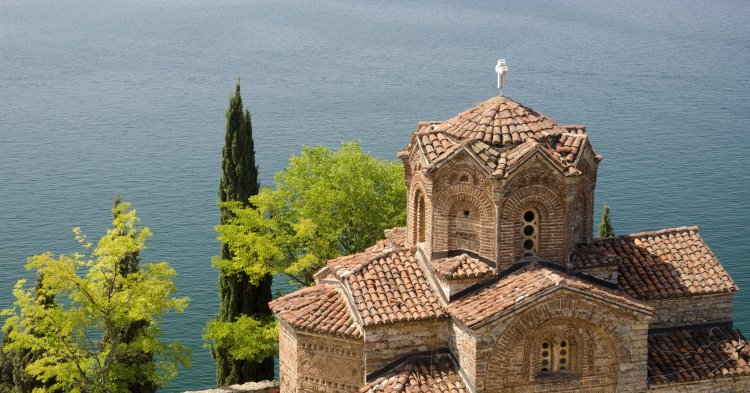Ohrid boasts a monastery and a lake with banks that are surrounded by magnificent mountains. A place this strategically situated has high historical significance. The small town in the west of North Macedonia faces its neighbour Albania and is around ten kilometres from Kosovo. It is historic because it was here that the Albanian minority and the former Macedonian Republic signed the Ohrid agreement on 13th August 2001, as a pledge to better represent Albanians in Macedonian society.
18 years later, under an autumnal sky that only added to the beauty of the lake, they met to negotiate a new agreement, this time about free trade. This agreement was quickly dubbed the Balkan “Mini Schengen Zone” by several of the key players in the region. Among them are the Albanian and North Macedonian Prime Ministers, Edi Rama and Zoran Zaev, the President of Serbia Aleksandar Vučić, the President of the Bosnian Council of Ministers Denis Zvizdić, and the Montenegrin Minister for Economic Affairs Dragica Sekulić.
The talks in Ohrid are happening as a result of the Serbian President and the Prime Minister of North Macedonia meeting on October 11th in Novi Sad, Serbia. This step further towards a free trade agreement was subsequently supported by North Macedonia, Albania and Serbia.
What will the proposed Balkan “Mini Schengen Zone” look like?
The different proposals that resulted from the negotiations in Ohrid concern free movement of goods, people, services, as well as capital.
Several advantages have been put forward in support of this project. The President of Serbia, notably claimed €220 million would be saved if a single market was created, saying that it would allow simplified trading without customs tariffs, and reduced administrative fees.
As for free movement of people, every citizen of each country in the agreement would be able to travel freely within the zone using only an identity card. Other advantages were also highlighted, such as better coordination against organised crime, easier exchange of students and qualified labourers and potentially even simplified documents for transporting goods. Generally, this free trade zone would be, according to its advocates, a boon for the development of the Western Balkans.
Who is involved in this project?
Despite its name and objective of grouping all the Western Balkan countries into a free trade area, it is vital that we remind ourselves of a few facts about the region. What are referred to as the Western Balkans, are the countries created after the fall of Yugoslavia (in addition to Albania). However, Slovenia is already part of the Schengen zone and Croatia is getting closer to joining the great European customs-free area. Therefore, the countries this project potentially applies to are: Bosnia and Herzegovina, Serbia, Montenegro, North Macedonia, Albania and Kosovo. However, they all have different opinions on the project.
Joining this free trade agreement is inconceivable for Kosovo
A few countries are reluctant to join. Kosovo was not represented in Ohrid on November 9th, and despite the discreet invitation of the Albanian Prime Minister, Edi Rama, Kosovo does not intend to take part in this project, its president, Hashim Thaçi, having been vocal in his denunciation of the project.
Firstly, Kosovo is still not recognised as an independent state by Serbia and Bosnia and Herzegovina; and it would be inconceivable for Kosovo to take part in something where the states were not equal. In addition to this, it wants to prioritise NATO and EU membership over a free trade deal of this kind. Finally, another argument put forward by the former Kosovo Prime Minister, Isa Mustafa, is that the project is more beneficial to some than others: “Such projects seem attractive at first glance, but in essence lead to a new Yugoslavia, with Albania, without Croatia and without Slovenia… Serbia and some other countries in the region are the ones who benefit from agreements like that of the Mini-Schengen”. Faced with the criticism of creating a ‘new Yugoslavia’, the Serbian President responded quickly. He explained that he simply wants to improve the lives of those in the region.
Montenegro and Bosnia and Herzegovina avoid commitment
Despite the fact she attended the meeting, the Montenegrin Minister of Economy, Dragica Sekulić, will not involve her country in the free trade area: ”I understand the initiators. These are the countries that, because of the various trade barriers they have placed on each other, may need a new initiative to promise again that they will do what we have long done.” She is referring to CEFTA, an agreement guaranteeing the free movement of people and goods in the countries of south-eastern Europe which includes Montenegro. Bosnia and Herzegovina is also wary and has not yet dared to say whether it will join this Balkan “Mini Schengen Zone”. However, Mirko Šarović, Minister for Foreign Trade looks on the project favourably and believes that it will have a positive influence on the region’s economy.
The steps ahead
The second meeting concerning a potential Balkan “Mini Schengen Zone” made progress on many proposals and confirmed that North Macedonia, Albania and Serbia want to do everything possible to see this project through to completion. The free trade zone will come into effect by 2021 according to the President of Serbia. The next meeting on this topic will take place on December 21st in Durrës, a coastal Albanian town. During this next meeting, the focus will be trying to fulfil some of proposals that were suggested at Ohrid, as well as others including simplifying movement in the “Mini Schengen Zone” for foreigners.
For now, many questions remain unanswered. Will Montenegro and Bosnia and Herzegovina join the initiative? What about Kosovo? What will this free trade area look like? Will this initiative affect the likelihood of future EU membership for the countries involved? Does the western Balkans region have a bright future ahead?

Follow the comments: |
|
